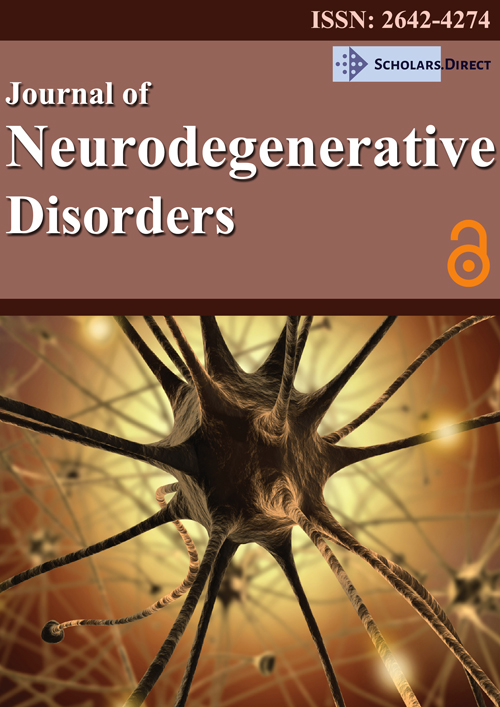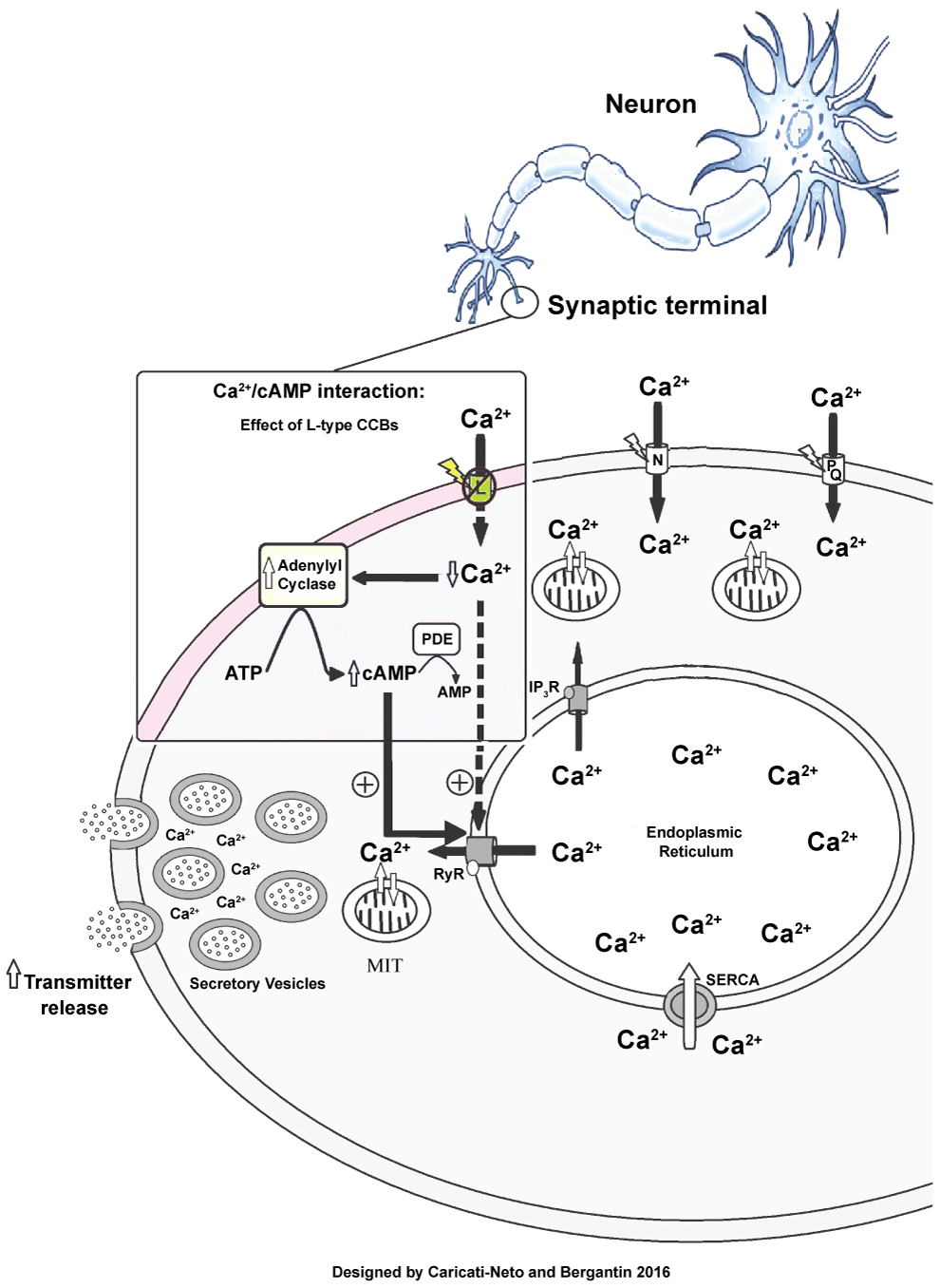Lessons from the Discovery of the Calcium Paradox due to Ca2+/Camp Interaction
Abstract
What have we learned from the discovery of the "calcium paradox" due to Ca2+/cAMP interaction? Our discovery of the involvement of interaction between the intracellular signalling pathways mediated by Ca2+ and cAMP (Ca2+/cAMP interaction) in the neuronal protection has produced new paths for the understanding of the cellular and molecular mechanisms involved in the pathogenesis of neurodegenerative diseases, such as Alzheimer's and Parkinson's diseases. Interestingly, tachycardia and increment of catecholamine plasma levels (sympathetic hyperactivity) have been reported by hypertensive patients that use L-type Ca2+ channel blockers (CCBs) since seventies. Despite these adverse effects of CCBs have been initially attributed to adjust reflex of arterial pressure, during almost four decades this enigmatic phenomenon named "calcium paradox" remained unclear. We revealed that this phenomenon was resulting of increase of transmitter release from sympathetic neurons stimulated by CCBs due to its interference on the Ca2+/cAMP interaction. In this way, novel journeys for the development of new pharmacological strategies more effective for the treatment of neurodegenerative diseases may be started.
Keywords
Ca2+/cAMP interaction, Calcium paradox, Neurodegenerative diseases
Introduction
The notion of stimulus-secretion initially resulted from the experiments performed by Douglas and Rubin in the sixties [1]. Using adrenal chromaffin cells, Baker and Knight revealed in seventies that a rise in the cytosolic Ca2+ concentration ([Ca2+]c), is an elementary requirement to trigger transmitter release [2]. The demonstration of direct relationship between rapid neurotransmitter release and rise in [Ca2+]c derived from the experiments using photo released caged Ca2+ in adrenal chromaffin cells performed Neher and Zucker in nineties [3]. Many results have shown that cAMP increases neurotransmitter release at many synapses in autonomic nervous system of vertebrate, including sympathetic neurons [4]. Although the cellular and molecular mechanisms involved in these synergistic effects of cAMP on the release of neurotransmitter and hormones are indistinct, the evidences suggest that this important intracellular messenger modulates intracellular signalling mediated by Ca2+ involved in the regulation of neurotransmitter, and hormones release.
Lessons from the Discovery of the Ca2+/cAMP Interaction
In fact, the hypothesis for a suitable interaction between the intracellular signalling pathways mediated by Ca2+ and cAMP, named Ca2+/cAMP interaction, has been widely studied in different cell types and tissues. In general, this interaction results in synergistic actions of these intracellular messengers on cell functions regulated by adenylyl cyclases (ACs), or phosphodiesterases (PDEs) [5-8]. The Ca2+/cAMP interaction has particularly been extensively studied at the endoplasmic reticulum (ER) Ca2+ channels, such as Ca2+ channels regulated by ryanodine receptors (RyR) [5-8]. Indeed, Ca2+/cAMP interaction plays a role in neurotransmitter release from neurons and neuroendocrine cells [5-8]. In addition, this interaction has been described in the smooth muscle [6], cardiac [9] and skeletal muscles [10]. Then, novel therapeutic goals for medicines could be developed by the manipulation of the Ca2+/cAMP interaction.
Lessons from the Discovery of the "Calcium Paradox" due to Ca2+/cAMP Interaction: Consequences in Neuronal Protection
Sympathetic hyperactivity such as tachycardia, and increment of catecholamine plasma levels have been evidenced by several medical studies dealing with CCBs [11]. Despite these adverse effects of CCBs have been initially attributed to adjust reflex of arterial pressure, during almost four decades the cellular and molecular mechanisms involved this enigmatic phenomenon named "calcium paradox" remained unclear.
In 2013, we discovered that "calcium paradox" phenomenon resulted from the increment of transmitter release from sympathetic neurons, and adrenal chromaffin cells, stimulated by CCBs due to its interference on the Ca2+/cAMP interaction. Using isolated tissues richly innervated by sympathetic nerves (rat vas deferens) to exclude the influence of adjusting reflex, we showed that neurogenic responses of the vas deferens were completely inhibited by L-type CCBs in high concentrations (> 1 μmol/L), but unpredictably and paradoxically, potentiated in concentrations below 1 μmol/L, characterized by sympathetic hyperactivity induced by CCBs [12-14]. Indeed, this paradoxical sympathetic hyperactivity is caused by increment of neurotransmitter release from sympathetic neurons due to its interference on the Ca2+/cAMP interaction. In fact, CCBs reduce the influx of extracellular Ca2+, thus promoting des inhibition of ACs activities (notable AC5 and AC6 isoforms), finally increasing cAMP levels [5-8] (Figure 1).
Schematic representation of the model: Ca2+ entry through L-type voltage-activated Ca2+ channels inhibits Ca2+-sensitive adenylyl cyclase, inhibiting cAMP signaling pathway-Ca2+ release from the endoplasmic reticulum. Typically, by reducing Ca2+ influx, and consequently [Ca2+]c, L-type CCBs may reduce transmitter release. However, CCBs may also activate Ca2+-sensitive adenylyl cyclase, activating cAMP signalling pathway-Ca2+ release from the endoplasmic reticulum. Ca2+ channel blockers (CCBs); Ryanodine Receptors (RyR); mitochondria (MIT); phosphodiesterase (PDE); adenosine triphosphate (ATP); cyclic adenosine monophosphate (cAMP); adenosine monophosphate (AMP); endoplasmic reticulum Ca2+-ATPase (SERCA).
Undeniably, several studies showed that neuroprotective response can be achieved by increase of cytosolic cAMP concentration ([cAMP]c) stimulation [15,16]. In this way, we could propose that a rise of [cAMP]c by interfering in the Ca2+/cAMP interaction could attenuate neuronal death triggered by cytosolic Ca2+ overload [5-8,17-22]. Then, the pharmacological handling of the Ca2+/cAMP interaction produced by combination of the L-type CCBs used in the antihypertensive therapy, and [cAMP]c enhancer compounds used in the anti-depressive therapy such as rolipram, could be a new pharmacological strategy for enhancing neurotransmission in neurological and psychiatric disorders resulting from neurotransmitter release deficit, and/or neuronal death [5-8,17-22]. Indeed, it was showed that the treatment with L-type CCBs reduces motor symptoms, and attenuates progressive neuronal death in animal model of degenerative disease, suggesting that L-type CCBs are potentially viable neuroprotective agents [23]. In addition, a 10-year follow-up study (2000 to 2010), involving 82,107 hypertensive patients of more than 60 years of age, showed that use of L-type CCBs reduced blood pressure and risk of dementia in hypertensive patients, suggesting that these drugs could be clinically used to treat Alzheimer's disease [24]. Supportive findings for the neuroprotective effects of CCBs have been demonstrated in 1,241 elderly hypertensive patients with memory impairment [25]. The use of CCBs decreased the risk of cognitive impairment, and Alzheimer's disease, independently of blood pressure levels, when compared to patients not receiving CCBs [25]. These findings reinforced the idea that attenuation of cytosolic Ca2+ overload produced by L-type CCBs due to blockade of Ca2+ influx through L-type voltage-activated Ca2+ channels could be an excellent pharmacological strategy to attenuate, or prevent, neuronal death in neurodegenerative diseases. These results could open a new path for the drug development more effective and safer for the treatment of neurodegenerative diseases.
Conclusion
Lessons from the discovery entitled "calcium paradox" due to Ca2+/cAMP interaction have been emerging to treat neurodegenerative diseases. Pharmacological handling of this interaction could be a more efficient and safer therapeutic strategy for stimulating neurotransmission compromised by neurotransmitter release deficit, and attenuating neuronal death in the neurodegenerative diseases.
References
- Douglas WW, Rubin RP (1961) The role of calcium in the secretory response of the adrenal medulla to acetylcholine. J Physiol 159: 40-57.
- Baker PF, Knight DE (1978) Calcium-dependent exocytosis in bovine adrenal medullary cells with leaky plasma membranes. Nature 276: 620-622.
- Neher E, Zucker RS (1993) Multiple calcium-dependent processes related to secretion in bovine chromaffin cells. Neuron 10: 21-30.
- Chern YJ, Kim KT, Slakey LL, et al. (1988) Adenosine receptors activate adenylate cyclase and enhance secretion from bovine adrenal chromaffin cells in the presence of forskolin. J Neurochem 50: 1484-1493.
- Caricati-Neto A, García AG, Bergantin LB (2015) Pharmacological implications of the Ca2+/cAMP signalling interaction: from risk for antihypertensive therapy to potential beneficial for neurological and psychiatric disorders. Pharmacol Res Perspect 3: e00181.
- Bergantin LB, Souza CF, Ferreira RM, et al. (2013) Novel model for "calcium paradox" in sympathetic transmission of smooth muscles: role of cyclic AMP pathway. Cell Calcium 54: 202-212.
- Bergantin LB, Jurkiewicz A, Garcia AG, et al. (2015) A Calcium Paradox in the Context of Neurotransmission. Journal of Pharmacy and Pharmacology 3: 253-261.
- Bergantin LB, Caricati-Neto A (2016) Challenges for the pharmacological treatment of neurological and psychiatric disorders: Implications of the Ca2+/cAMP intracellular signalling interaction. Eur J Pharmacol 788: 255-260.
- Yu HJ, Ma H, Green RD (1993) Calcium entry via L-type calcium channels acts as a negative regulator of adenylyl cyclase activity and cyclic AMP levels in cardiac myocytes. Mol Pharmacol 44: 689-693.
- Menezes-Rodrigues FS, Pires-Oliveira M, Duarte T, et al. (2013) Calcium influx through L-type channels attenuates skeletal muscle contraction via inhibition of adenylyl cyclases. Eur J Pharmacol 720: 326-334.
- Grossman E, Messerli FH (1998) Effect of calcium antagonists on sympathetic activity. Eur Heart J 19: F27-F31.
- Kreye VA, Luth JB (1975) Proceedings: verapamil-induced phasic contractions of the isolated rat vas deferens. Naunyn Schmiedebergs Arch Pharmacol 287: R43.
- French AM, Scott NC (1981) A comparison of the effects of nifedipine and verapamil on rat vas deferens. Br J Pharmacol 73: 321-323.
- Moritoki H, Iwamoto T, Kanaya J, et al. (1987) Verapamil enhances the non-adrenergic twitch response of rat vas deferens. Eur J Pharmacol 140: 75-83.
- Sommer N, Loschmann PA, Northoff GH, et al. (1995) The antidepressant rolipram suppresses cytokine production and prevents autoimmune encephalomyelitis. Nat Med 1: 244-248.
- Xiao L, O'Callaghan JP, O'Donnell JM (2011) Effects of repeated treatment with phosphodiesterase-4 inhibitors on cAMP signaling, hippocampal cell proliferation, and behavior in the forced-swim test. J Pharmacol Exp Ther 338: 641-647.
- Bergantin LB, Caricati-Neto A (2016) Novel Insights for Therapy of Parkinson's disease: Pharmacological Modulation of the Ca2+/cAMP Signalling Interaction. Austin Neurol & Neurosci 1: 1009.
- Bergantin LB, Caricati-Neto A (2016) Recent advances in pharmacotherapy of neurological and psychiatric disorders promoted by discovery of the role of Ca2+/cAMP signaling interaction in the neurotransmission and neuroprotection. Adv Pharmac J 1: 66-70.
- Bergantin LB, Caricati-Neto A (2016) From discovering "calcium paradox" to Ca2+/cAMP Interaction: Impact in Human Health and Disease. Scholars' Press, 108.
- Caricati-Neto A, Bergantin LB (2016) New therapeutic strategy of Alzheimer's and Parkinson's diseases: Pharmacological modulation of neural Ca2+/cAMP intracellular signaling interaction. Asian Journal of Pharmacy and Pharmacology 2: 136-143.
- Bergantin LB, Caricati-Neto A (2016) Impact of interaction of Ca2+ /cAMP Intracellular Signalling Pathways in Clinical Pharmacology and Translational Medicine. Clin Pharmacol Transl Med 1-4.
- Bergantin LB, Caricati-Neto A (2016) Challenges for the Pharmacological Treatment of Dementia: Implications of the Ca2+ /cAMP Intracellular Signalling Interaction. Avidscience 2-25.
- Ilijic E, Guzman JN, Surmeier DJ (2011) The L-type channel antagonist isradipine is neuroprotective in a mouse model of Parkinson's disease. Neurobiol Dis 43: 364-371.
- Wu CL, Wen SH (2016) A 10-year follow-up study of the association between calcium channel blocker use and the risk of dementia in elderly hypertensive patients. Medicine (Baltimore) 95: e4593.
- Hanon O, Pequignot R, Seux ML, et al. (2006) Relationship between antihypertensive drug therapy and cognitive function in elderly hypertensive patients with memory complaints. J Hypertens 24: 2101-2107.
Corresponding Author
Leandro Bueno Bergantin, Department of Pharmacology, Laboratory of Autonomic and Cardiovascular Pharmacology, Escola Paulista de Medicina, Universidade Federal de São Paulo (UNIFESP), Rua Pedro de Toledo, 669, Vila Clementino, São Paulo, SP, CEP: 04039-032, Brazil, Tel: +55-11-5576-4973.
Copyright
© 2017 Bergantin LB, et al. This is an open-access article distributed under the terms of the Creative Commons Attribution License, which permits unrestricted use, distribution, and reproduction in any medium, provided the original author and source are credited.





